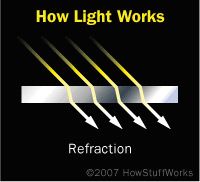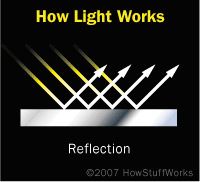Light as Rays
Imagining light as a ray makes it easy to describe, with great accuracy, three well-known phenomena: reflection, refraction and scattering. Let's take a second to discuss each one.
In reflection, a light ray strikes a smooth surface, such as a mirror, and bounces off. A reflected ray always comes off the surface of a material at an angle equal to the angle at which the incoming ray hit the surface. In physics, you'll hear this called the law of reflection. You've probably heard this law stated as "the angle of incidence equals the angle of reflection."
Advertisement
Of course, we live in an imperfect world and not all surfaces are smooth. When light strikes a rough surface, incoming light rays reflect at all sorts of angles because the surface is uneven. This scattering occurs in many of the objects we encounter every day. The surface of paper is a good example. You can see just how rough it is if you peer at it under a microscope. When light hits paper, the waves are reflected in all directions. This is what makes paper so incredibly useful -- you can read the words on a printed page regardless of the angle at which your eyes view the surface.

Refraction occurs when a ray of light passes from one transparent medium (air, let's say) to a second transparent medium (water). When this happens, light changes speed and the light ray bends, either toward or away from what we call the normal line, an imaginary straight line that runs perpendicular to the surface of the object. The amount of bending, or angle of refraction, of the light wave depends on how much the material slows down the light. Diamonds wouldn't be so glittery if they didn't slow down incoming light much more than, say, water does. Diamonds have a higher index of refraction than water, which is to say that those sparkly, costly light traps slow down light to a greater degree.
Lenses, like those in a telescope or in a pair of glasses, take advantage of refraction. A lens is a piece of glass or other transparent substance with curved sides for concentrating or dispersing light rays. Lenses serve to refract light at each boundary. As a ray of light enters the transparent material, it is refracted. As the same ray exits, it's refracted again. The net effect of the refraction at these two boundaries is that the light ray has changed directions. We take advantage of this effect to correct a person's vision or enhance it by making distant objects appear closer or small objects appear bigger.
Unfortunately, a ray theory can't explain all of the behaviors exhibited by light. We'll need a few other explanations, like the one we'll cover next.
